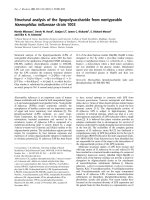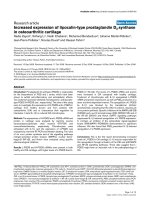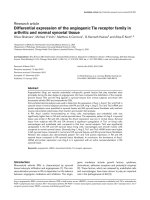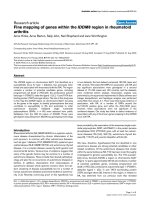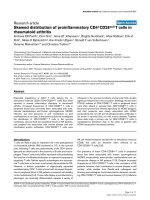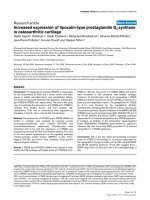Báo cáo y học: " Mild episodes of tourniquet-induced forearm ischaemia-reperfusion injury results in leukocyte activation and changes in inflammatory and coagulation markers" pptx
Bạn đang xem bản rút gọn của tài liệu. Xem và tải ngay bản đầy đủ của tài liệu tại đây (384.19 KB, 8 trang )
BioMed Central
Page 1 of 8
(page number not for citation purposes)
Journal of Inflammation
Open Access
Research
Mild episodes of tourniquet-induced forearm ischaemia-reperfusion
injury results in leukocyte activation and changes in inflammatory
and coagulation markers
Stephen F Hughes*
1,6
, Beverly D Hendricks
2
, David R Edwards
3
,
Salah S Bastawrous
4
, Gareth E Roberts
5
and Jim F Middleton
6
Address:
1
Chemical Pathology Department, Glan Clwyd Hospital, Sarn Lane, Rhyl, Denbighshire, UK,
2
Haematology Department, Glan Clwyd
Hospital, Sarn Lane, Rhyl, Denbighshire, UK,
3
Haematology Department, Gwynedd Hospital, Penrhosgarnedd, Bangor, Gwynedd, UK,
4
Orthopaedics Department, Glan Clwyd Hospital, Sarn Lane, Rhyl, Denbighshire, UK,
5
Anaesthetics Department, Gwynedd Hospital,
Penrhosgarnedd, Bangor, Gwynedd, UK and
6
Leopold Muller Arthritis Research Centre, School of Medicine, Keele University at Robert Jones and
Agnes Hunt Orthopaedic Hospital, Oswestry, UK
Email: Stephen F Hughes* - ; Beverly D Hendricks - ;
David R Edwards - ; Salah S Bastawrous - ;
Gareth E Roberts - ; Jim F Middleton -
* Corresponding author
Abstract
Background: Monocytes and neutrophils are examples of phagocytic leukocytes, with neutrophils being considered as
the 'chief' phagocytic leukocyte. Both monocytes and neutrophils have been implicated to play a key role in the
development of ischaemia-reperfusion injury, where they are intrinsically involved in leukocyte-endothelial cell
interactions. In this pilot study we hypothesised that mild episodes of tourniquet induced forearm ischaemia-reperfusion
injury results in leukocyte activation and changes in inflammatory and coagulation markers.
Methods: Ten healthy human volunteers were recruited after informed consent. None had any history of cardiovascular
disease with each subject volunteer participating in the study for a 24 hour period. Six venous blood samples were
collected from each subject volunteer at baseline, 10 minutes ischaemia, 5, 15, 30, 60 minutes and 24 hours reperfusion,
by means of a cannula from the ante-cubital fossa. Monocyte and neutrophil leukocyte sub-populations were isolated by
density gradient centrifugation techniques. Leukocyte trapping was investigated by measuring the concentration of
leukocytes in venous blood leaving the arm. The cell surface expression of CD62L (L-selectin), CD11b and the
intracellular production of hydrogen peroxide (H
2
O
2
) were measured via flow cytometry. C-reactive protein (CRP) was
measured using a clinical chemistry analyser. Plasma concentrations of D-dimer and von Willebrand factor (vWF) were
measured using enzyme-linked fluorescent assays (ELFA).
Results: During ischaemia-reperfusion injury, there was a decrease in CD62L and an increase in CD11b cell surface
expression for both monocytes and neutrophils, with changes in the measured parameters reaching statistical significance
(p =< 0.05). A significant decrease in peripheral blood leukocyte concentration was observed during this process, which
was measured to assess the degree of leukocyte trapping in the micro-circulation (p =< 0.001). There was an increase
in the intracellular production of H
2
O
2
production by leukocyte sub-populations, which was measured as a marker of
leukocyte activation. Intracellular production of H
2
O
2
in monocytes during ischaemia-reperfusion injury reached
statistical significance (p = 0.014), although similar trends were observed with neutrophils these did not reach statistical
significance. CRP was measured to assess the inflammatory response following mild episodes of ischaemia-reperfusion
injury and resulted in a significant increase in the CRP concentration (p =< 0.001). There were also increased plasma
Published: 30 May 2007
Journal of Inflammation 2007, 4:12 doi:10.1186/1476-9255-4-12
Received: 1 February 2007
Accepted: 30 May 2007
This article is available from: />© 2007 Hughes et al; licensee BioMed Central Ltd.
This is an Open Access article distributed under the terms of the Creative Commons Attribution License ( />),
which permits unrestricted use, distribution, and reproduction in any medium, provided the original work is properly cited.
Journal of Inflammation 2007, 4:12 />Page 2 of 8
(page number not for citation purposes)
concentrations of D-dimer and a trend towards elevated vWF levels, which were measured as markers of coagulation
activation and endothelial damage respectively. Although significant changes in D-dimer concentrations were observed
during ischaemia-reperfusion injury (p = 0.007), measurement of the vWF did not reach statistical significance.
Conclusion: Tourniquet induced forearm ischaemia-reperfusion injury results in increased adhesiveness, trapping and
activation of leukocytes. We report that, even following a mild ischaemic insult, this leukocyte response is immediately
followed by evidence of increased inflammatory response, coagulation activity and endothelial damage. These results may
have important implications and this pilot study may lead to a series of trials that shed light on the mechanisms of
ischaemia-reperfusion injury, including potential points of therapeutic intervention for pathophysiological conditions.
Background
The vascular endothelium is a major structural and func-
tional component of all tissues. Endothelial cells are local-
ised between the intravascular and extravascular spaces,
and these cells play an important role in regulating vascu-
lar homeostasis. The endothelium regulates blood coagu-
lation, blood flow, and various inflammatory processes
such as controlling leukocyte migration, adhesion and
activation [1].
Phagocytic leukocytes are components of the non-specific
immune system. They are capable of phagocytosis and
destroy damaged tissue cells and invading pathogens such
as bacteria. Monocytes and neutrophils are examples of
phagocytic leukocytes, with neutrophils being considered
as the 'chief' phagocytic leukocyte. Both monocytes and
neutrophils have been implicated to play a key role in the
development of ischaemia-reperfusion injury, where they
are intrinsically involved in leukocyte-endothelial cell
interactions [2].
Ischaemia-reperfusion injury occurs in diseases such as
ischemic heart disease, and during surgical procedures,
which involve the application of a tourniquet, such as
knee arthroplasty and total knee replacement [3-7]. Dur-
ing ischaemia-reperfusion injury it can be appreciated that
interactions between the phagocytic leukocyte and
endothelium involve the expression of various adhesion
molecules. Specific adhesion molecules important in
mediating adhesive interactions include CD62L (L-selec-
tin) and CD11b (Mac-1) on monocytes and neutrophils.
These bind to their corresponding counter-receptors to
facilitate leukocyte-endothelial cell interactions [8-10].
Ischaemia-reperfusion injury causes activation of mono-
cytes and neutrophils and adhesion of these cells to the
endothelium (trapping) [11,12]. This results in the pro-
duction and release of reactive oxygen intermediates
(ROIs), such as hydrogen peroxide, by activated leuko-
cytes. These cause endothelial dysfunction which itself
accelerates the atherosclerotic process which might lead to
its final complication resulting in myocardial infarction,
stroke and peripheral vascular disease [13-20].
A previous study has recently demonstrated the role of
leukocytes in damage to the vascular endothelium during
ischaemia-reperfusion injury. This investigation verified
leukocyte involvement during ischaemia-reperfusion
injury, and provided evidence of increased endothelial
cell damage, following relatively short periods of reper-
fusion [4]. The present report consists of a human study
that employed an adapted model of ischaemia-reper-
fusion injury. It aimed to assess the role of leukocytes dur-
ing this process, as well as to investigate the inflammatory
and coagulation response. This determined whether sus-
tained endothelial damage is incurred, following mild
ischaemia, together with reperfusion measured at various
time intervals.
Methods
Subject volunteers
Ethical approval for this pilot analysis study was received
from the local research ethics committee (North Wales
Central Research Ethics Committee, Reference Number –
05/WNo02/26). Ten healthy human volunteers were
selected upon completing a health questionnaire to
exclude individuals with cardiovascular disease such
atherosclerosis and inflammatory disorders such as arthri-
tis, and were recruited after informed consent (5 males
and 5 females, mean age = 43).
Blood collection and cell counting
Venous blood samples were collected into vacutainers
containing di-potassium ethylene diamine tetra-acetic
acid (EDTA) (1.5 mg/ml), tri-sodium citrate (0.11 mol/l)
and serum clot activator (Greiner Bio-one, UK). Full
blood counts were performed using a Coulter
®
MicoDiff
18
automated cell counter (Beckman Coulter, UK).
Model of tourniquet-induced forearm ischaemia-
reperfusion injury
This model provided an adapted method of tourniquet-
induced forearm ischaemia-reperfusion injury. During
this study all subject volunteers were extubated prior to
commencing the investigations with an 18GA cannula
(BD Venflon™, Sweden), which was inserted into the ante-
cubital fossa of the experimental arm. This was as a con-
trol measurement for that particular individual.
Journal of Inflammation 2007, 4:12 />Page 3 of 8
(page number not for citation purposes)
A sphygmomanometer was then placed around the upper
experimental arm and inflated to approximately 20–40
mmHg for ten minutes as described by others [4,21-23].
This procedure reduced blood flow to the arm (ischae-
mia), following which time a blood sample was taken.
The cuff was then removed to allow full blood flow to the
arm (reperfusion). Further blood samples were then col-
lected, by means of the cannula at various time intervals
(5, 15, 30 and 60 minutes). After collection of the 60
minute blood sample, the cannula was removed. Twenty
four hours later a final blood sample was collected from
the experimental arm by venepuncture.
Preparation of cell suspensions
Purified neutrophils and mononuclear cell suspensions
were prepared by density gradient sedimentation on ficoll
hypaque solutions as described by Lennie et al, (1987)
[24]. Following isolation, cells were re-suspended in
phosphate buffered saline (PBS) supplemented with di-
potassium EDTA (1.5 mg/ml) to yield a final cell count of
2 × 10
6
cells/ml. All chemicals were supplied by Sigma-
Aldrich, UK.
Measurement of cell surface expression of CD62L
The monoclonal antibodies used were mouse anti-human
CD62L (MCA1076F) and isotype-matched control IgG2b
(MCA691F) and were purified immunoglobulin/fluoro-
rescein isothiocyanate (Ig/FITC) conjugates (AbD Serotec
Ltd., U.K.). Following isolation of leukocyte subpopula-
tions and adjustment of concentration (2 × 10
6
cells/ml),
10 μl of the monoclonal antibody (0.1 mg/ml) was added
to 100 μl of the appropriate cell suspension. These were
incubated at room temperature for 30 minutes, prior to
assay analysis using flow cytometry of gated monocytes
and neutrophils (Figure 1).
Measurement of cell surface expression of CD11b
The monoclonal antibodies used were mouse anti-human
CD11b (MCA551F) and isotype-matched control IgG1
(MCA928F) and were purified immunoglobulin/fluoro-
rescein isothiocyanate (Ig/FITC) conjugates (AbD Serotec
Ltd., U.K.). Following isolation of leukocyte subpopula-
tions and adjustment of concentration (2 × 10
6
cells/ml),
10 μl of the monoclonal antibody (0.1 mg/ml) was added
to 100 μl of the appropriate cell suspension. These were
incubated at room temperature for 30 minutes, prior to
assay analysis using flow cytometry of gated monocytes
and neutrophils (Figure 1).
Measurement of intracellular hydrogen peroxide
production
Cells were isolated and intracellular H
2
O
2
production was
assessed by adaptation of a technique previously
described by Bass et al (1983) [25]. The assay was based
on the oxidation by H
2
O
2
of non-fluorescent 2', 7'-dichlo-
rofluoroscin diacetate (DCFH-DA) to stable and fluores-
cent dichlorofluoroescein. H
2
O
2
production was assessed
in cells using a fixed volume of 0.5 ml cell suspension (2
× 10
6
cells/ml) mixed with 0.5 ml DCFH-DA (20 μM) in
PBS. Cells were incubated in the dark, at 37°C for 30 min-
utes before immediate measurement using flow cytometry
of gated monocytes and neutrophils (Figure 1).
Measurement of C-reactive protein (CRP)
Measurement of C-reactive protein was performed using
an ILAB 600 clinical chemistry analyser (Instrumentation
Laboratory, UK). Highly sensitive CRP was measured
using the Quantex CRP plus kits which were supplied by
Bio-kit (Spain) and involved using a turbidimetric assay
as previously described by Price et al (1987) [26].
Measurement of plasma concentration of D-dimer and
von Willebrand Factor (vWF)
Blood samples were collected into tri-sodium citrate tubes
and were centrifuged at 1500 g for 10 minutes within 4
hours of blood collection. Plasma was removed and
stored at -30°C. Plasma concentrations of D-dimer and
vWF were measured by a two step enzyme immunoassay
sandwich method, with a final fluorescent detection as
described by others [27,28]. Measurement of these param-
eters was performed using a Mini-Vidas automated immu-
noassay system that uses ELFA (Enzyme-Linked
Fluorescent Assay) technology. The Mini-Vidas system
and immunoassay kits were supplied from Biomerieux,
UK.
Gating of phagocytic leukocyte sub-populations during flow cytometric analysesFigure 1
Gating of phagocytic leukocyte sub-populations dur-
ing flow cytometric analyses. Gates were adjusted so
that the percentage of cells analysed were identical to those
identified using a Coulter
®
MicroDiff
18
apparatus. Lym-
phocytes, red blood cells and debris were excluded from
defined gates [4]. Leukocyte subpopulations were selected by
assignment of gates normally associated with (A) monocytes
and (B) neutrophils [36]. All flow cytometric analyses were
performed using a Becton and Dickenson FACSCalibur flow
cytometer.
(A) (B)
Journal of Inflammation 2007, 4:12 />Page 4 of 8
(page number not for citation purposes)
Statistical analysis
During this convenience pilot analysis study results are
presented as mean ± SEM; n indicates the number of par-
ticipants in the study. Changes in the measured parame-
ters during ischaemia and reperfusion were determined by
repeated measures analysis of variance (ANOVA – using
the sweeping by treatment method) and the paired t test.
Statistical significance was accepted when p ≤ 0.05. All sta-
tistical analysis was performed using Minitab Release 13
software package (Minitab Ltd, UK).
Results
Effect of tourniquet induced forearm ischaemia-
reperfusion injury on CD62L (L-selectin) and CD11b cell
surface expression of monocytes and neutrophils (n = 10)
During the experimental stages of ischaemia and reper-
fusion there was a significant effect on CD62L expression
(p = 0.006 for monocytes and p =< 0.001 for neutrophils).
This expression on both monocytes and neutrophils
decreased from baseline to 60 minutes reperfusion (32.84
± 2.84 – 27.07 ± 1.98 monocytes; 31.88 ± 2.67 to 25.42 ±
1.90 neutrophils) (Figure 2). The CD62L cell surface
expression for both cell types returned towards basal lev-
els following 24 hours reperfusion (30.06 ± 2.38 mono-
cytes; 28.99 ± 2.19 neutrophils), although this was
expressed at a lower level to that of baseline.
There was a significant effect of ischaemia and reperfusion
on CD11b cell surface expression of monocytes (p =
0.005) and neutrophils (p = 0.009) (Figure 3). Results
show that during 10 minutes ischaemia and 5 minutes
reperfusion there is an increase in CD11b cell surface
expression on monocytes and neutrophils. Following 24
hours reperfusion CD11b cell surface expression
decreased and did not significantly differ from basal lev-
els. The CD11b cell surface expression in monocytes was
consistently higher than that seen in neutrophils.
Effect of tourniquet induced forearm ischaemia-
reperfusion injury on leukocyte trapping and activation (n
= 10)
There was evidence of increased leukocyte trapping during
ischaemia and reperfusion, with the measured changes in
the total leukocyte concentrations reaching statistical dif-
ference (p =< 0.001). The total leukocyte concentration
decreased from 6.810 ± 0.48 at baseline to 5.82 ± 0.39 at
5 minutes reperfusion (p = 0.003) (Figure 4). Following
24 hours reperfusion the total leukocyte concentration
increased back towards basal levels (6.17 ± 0.45) yet
remained significantly lower (p = 0.027).
Both monocytes and neutrophils displayed an increase in
the intracellular production of H
2
O
2
from baseline up to
30 minutes reperfusion (141.6 ± 16.7 – 205.1 ± 28.6
monocytes (p =< 0.001); 194.9 ± 23.6 – 257.5 ± 22.9 neu-
trophils (p =< 0.001). Following 24 hours reperfusion the
intracellular production of H
2
O
2
by monocytes and neu-
trophils decreased back towards basal levels, although
these remained at higher measurements to that of base-
line (199.3 ± 31.3 monocytes (p = 0.014); 208.6 ± 13.8
neutrophils (p => 0.05)) (Figure 5). Neutrophils also dis-
played increased intracellular production of H
2
O
2
com-
pared to monocytes.
Effect of tourniquet induced forearm ischaemia-
reperfusion injury on the inflammatory response,
coagulation activity and endothelial damage (n = 10)
Our study demonstrated that there was a significant effect
of experimental ischaemia and reperfusion on the CRP (p
=< 0.001) and D-dimer (p = 0.007). These parameters
were measured as markers of the inflammatory response
and coagulation activity respectively. The CRP concentra-
tion increased from baseline, during ischaemia, and peak-
ing at 15 minutes reperfusion (0.47 ± 0.47 – 1.25 ± 0.20
p < 0.001). Following 24 hours reperfusion the CRP con-
centration decreased, although this was expressed at a
higher concentration to that of basal levels (0.91 ± 0.26)
(Figure 6).
D-dimer concentration in the plasma was significantly
affected by ischaemia and reperfusion (p = 0.007). Levels
increased from baseline during ischaemia, and peaked at
15 minutes reperfusion (410 ± 102 – 520 ± 106; p =
Effect of tourniquet induced forearm ischaemia-reperfusion injury on CD62L cell surface expression of monocytes and neutrophilsFigure 2
Effect of tourniquet induced forearm ischaemia-
reperfusion injury on CD62L cell surface expression
of monocytes and neutrophils. The results are expressed
as mean fluorescent intensity (MFI) and represent the
changes in the CD62L (L-selectin) cell surface expression of
monocytes and neutrophils during the experimental stages of
ischaemia-reperfusion injury. The points represent mean ±
SEM, p = 0.006 (monocytes) and p =< 0.001 (neutrophils), as
determined by ANOVA. *p =< 0.05 Baseline vs ischaemia
and 60 minutes reperfusion for both monocytes and neu-
trophils, n = 10.
22
24
26
28
30
32
34
36
38
40
Baseline Ischaemia 5 Minutes
Reperfusion
15 Minutes
Reperfusion
30 Minutes
Reperfusion
60 Minutes
Reperfusion
24 Hours
Reperfusion
M
ean Fluorescent Intensity (MF
I)
Monocytes Neutrophils
*
*
Journal of Inflammation 2007, 4:12 />Page 5 of 8
(page number not for citation purposes)
0.046) (Figure 7). Following 24 hours reperfusion the D-
dimer concentration decreased, although this was present
at a slightly lower concentration (329.5 ± 88.6) to that of
basal levels.
Host cell damage during an episode of ischaemia and
reperfusion was assessed via measurement of vWF con-
centration, which is an established marker of endothelial
damage [29]. During this study, changes in vWF concen-
tration during ischaemia and reperfusion resulted in an
increase in vWF concentration from baseline and peaking
at 30 minutes reperfusion (1.07 ± 0.11 – 1.42 ± 0.19) (Fig-
ure 8). Following 24 hours reperfusion the vWF concen-
tration decreased, although this was expressed at a higher
concentration to that of basal levels (1.24 ± 0.17). How-
ever, none of these changes reached statistical difference.
Discussion
An important aspect of this study was to provide a better
understanding of the mechanisms by which phagocytic
leukocytes are involved in ischaemia-reperfusion injury.
Using a model of mild ischaemia-reperfusion injury in
normal humans, we established that monocytes and neu-
trophils analysed ex vivo showed evidence of increased
adhesion, trapping and activation. This was associated
with in increased inflammatory response, coagulation
activity and a trend towards sustained endothelial dam-
age.
It can be appreciated that the adhesion and transendothe-
lial migration of leukocytes into the surrounding tissues
Effect of tourniquet induced forearm ischaemia-reperfusion injury on intracellular H
2
O
2
production of monocytes and neutrophilsFigure 5
Effect of tourniquet induced forearm ischaemia-
reperfusion injury on intracellular H
2
O
2
production
of monocytes and neutrophils. The results are expressed
as mean fluorescent intensity (MFI) and represent the
changes in the intracellular H
2
O
2
production of monocytes
and neutrophils during the experimental stages of ischaemia-
reperfusion injury. The points represent mean ± SEM, p =<
0.001 for both monocytes and neutrophils, as determined by
ANOVA. *p =< 0.05 Baseline vs 30 minutes (monocytes and
neutrophils) and 24 hours reperfusion (monocytes), n = 10.
120
140
160
180
200
220
240
260
280
300
Baseline Ischaemia 5 Minutes
Reperfusion
15 Minutes
Reperfusion
30 Minutes
Reperfusion
60 Minutes
Reperfusion
24 Hours
Reperfusion
Mean Fluorescent Intensity (MFI)
Monocytes Neutrophils
*
*
Effect of tourniquet induced forearm ischaemia-reperfusion injury on CD11b cell surface expression of monocytes and neutrophilsFigure 3
Effect of tourniquet induced forearm ischaemia-
reperfusion injury on CD11b cell surface expression
of monocytes and neutrophils. The results are expressed
as mean fluorescent intensity (MFI) and represent the
changes in the CD11b cell surface expression of monocytes
and neutrophils during the experimental stages of ischaemia-
reperfusion injury. The points represent mean ± SEM, p =
0.005 (monocytes) and p = 0.009 (neutrophils), as deter-
mined by ANOVA. *p =< 0.05 Baseline vs ischaemia and 5
minutes reperfusion for both monocytes and neutrophils, n =
10.
20
25
30
35
40
45
50
Baseline Ischaemia 5 Minutes
Reperfusion
15 Minutes
Reperfusion
30 Minutes
Reperfusion
60 Minutes
Reperfusion
24 Hours
Reperfusion
M
ean Fluorescent Intensity (MF
I)
Monocytes Neutrophils
*
*
Effect of tourniquet induced forearm ischaemia-reperfusion injury on total leukocyte concentrationFigure 4
Effect of tourniquet induced forearm ischaemia-
reperfusion injury on total leukocyte concentration.
The results are expressed as total leukocyte concentration
(10
9
/l). The points represent mean ± SEM, p =< 0.001, as
determined by ANOVA. *p =< 0.05 Baseline vs ischaemia, 5
minutes and 24 hours reperfusion, n = 10.
5
5.5
6
6.5
7
7.5
8
Baseline Ischaemia 5 Minutes
Reperfusion
15 Minutes
Reperfusion
30 Minutes
Reperfusion
60 Minutes
Reperfusion
24 Hours
Reperfusion
L
eukocyte concentration (*10^9
/l)
*
*
*
Journal of Inflammation 2007, 4:12 />Page 6 of 8
(page number not for citation purposes)
are crucial steps in inflammation, immunity, atherogene-
sis, and during ischaemia-reperfusion injury [4,30-32].
The present study was designed to ascertain whether
ischaemia-reperfusion injury in normal individuals
results in changes in the cell surface expression of the
CD62L and CD11b adhesion molecules, and to specifi-
cally assess the leukocyte adhesion cascade in response to
episodes of mild ischaemia and subsequent reperfusion.
During this investigation there was evidence of increased
shedding of CD62L from the cell surface of both mono-
cytes and neutrophils, and our results support the evi-
dence that CD62L plays a key role during the early stages
of the leukocyte adhesion cascade, which facilitates leuko-
cyte adhesion to the endothelium.
This was supported by the up-regulation of the CD11b
cell surface adhesion molecules by both monocytes and
neutrophils. This suggests that during ischaemia-reper-
fusion injury CD11b expressed on the cell surface of
phagocytic leukocytes binds to counter-receptors, such as
intercellular adhesion molecule-1 (ICAM-1), expressed
on the surface of vascular endothelium, which facilitate
leukocyte-endothelial interactions. In agreement with
others, this increased expression of CD11b on leukocytes
may therefore play a central role as the mechanism by
which leukocyte adhesion, and consequently trapping in
the microcirculation occurs during ischaemia-reperfusion
injury [4].
To assess the degree of leukocyte trapping, as a result of
adhesion of leukocytes to the endothelium, changes in the
leukocyte concentration were measured in venous blood
taken from the forearm. This was assessed by measure-
ment of a full blood count using an automated cell coun-
ter as described previously [4]. Trapping of leukocytes to
the endothelium would result in a decrease in the number
of leukocytes leaving the arm [4]. Evidence of increased
leukocyte trapping in blood vessels was supported by the
reduction in monocyte and granulocyte cell numbers, and
the increased shedding of CD62L and up-regulation in
CD11b cell surface expression of monocytes and neu-
trophils. Collectively, it can be appreciated that in the
present model these intrinsic events may play a key role
Effect of tourniquet induced forearm ischaemia-reperfusion injury on C-reactive protein (CRP) concentrationFigure 6
Effect of tourniquet induced forearm ischaemia-
reperfusion injury on C-reactive protein (CRP) con-
centration. The results are expressed as CRP concentra-
tion (ng/ml). The points represent mean ± SEM, p =< 0.001,
as determined by ANOVA. *p =< 0.001 Baseline vs ischaemia
and 15 minutes reperfusion, n = 10.
Effect of tourniquet induced forearm ischaemia-reperfusion injury on D-dimer concentrationFigure 7
Effect of tourniquet induced forearm ischaemia-
reperfusion injury on D-dimer concentration. The
results are expressed as D-dimer concentration (ng/ml). The
points represent mean ± SEM, p = 0.007, as determined by
ANOVA. *p = 0.046 Baseline vs 15 minutes reperfusion, n =
10.
200
250
300
350
400
450
500
550
600
650
700
Baseline
Ischaemia 5 Minutes
Reperfusion
15 Minutes
Reperfusion
30 Minutes
Reperfusion
60 Minutes
Reperfusion
24 Hours Reperfusion
D
-Dimer concentration (ng/m
l)
*
Effect of tourniquet induced forearm ischaemia-reperfusion injury on vWF concentrationFigure 8
Effect of tourniquet induced forearm ischaemia-
reperfusion injury on vWF concentration. The results
are expressed as vWF concentration (ng/ml). The points rep-
resent mean ± SEM, p = 0.687, as determined by ANOVA, n
= 10.
0.9
1
1.1
1.2
1.3
1.4
1.5
1.6
1.7
Baseline Ischaemia 5 Minutes
Reperfusion
15 Minutes
Reperfusion
30 Minutes
Reperfusion
60 Minutes
Reperfusion
24 Hours
Reperfusion
v
WF concentration (IU/m
l)
Journal of Inflammation 2007, 4:12 />Page 7 of 8
(page number not for citation purposes)
during leukocyte adhesion to the endothelium of the
microcirculation.
Increased leukocyte adhesion to the vascular endothelium
during ischaemia-reperfusion leads to cell activation.
Using tourniquet induced forearm ischaemia-reperfusion,
we then investigated leukocyte activation by measuring
the intracellular production of H
2
O
2
by monocytes and
neutrophils. Evidence of leukocyte activation during the
experimental stages of tourniquet induced forearm ischae-
mia and reperfusion was supported by the increase in
intracellular H
2
O
2
production of monocytes and neu-
trophils. In addition, during leukocyte activation it can be
appreciated that further bioactive material, such as other
ROIs and proteolytic enzymes are released extracellularly
[33,34]. Collectively, the actions of these degradative sub-
stances may potentially cause damage to host tissue in the
current model. Measurement of the intracellular produc-
tion of H
2
O
2
by phagocytic leukocytes may therefore pro-
vide a useful marker that could be applied to monitoring
various diseases such as atherosclerosis and ischaemic
heart disease, conditions where ischaemia-reperfusion
injury can be appreciated to be an underlying process [4].
Another aspect of this study was to assess the inflamma-
tory response, coagulation activity, and any endothelial
damage that may be incurred, during tourniquet induced
forearm ischaemia and various reperfusion time periods.
Increased CRP concentration during these studies demon-
strated that there was a mild inflammatory response dur-
ing ischaemia and reperfusion, although clinically these
may not be of significant concerns as all results are within
the normal clinical reference range. It is proposed that the
inflammatory changes observed during this study may be
due to the release of cytokines such as interleukin-6 (IL-6)
from the activated cells during mild episodes of ischae-
mia-reperfusion injury [35].
Changes in the D-dimer concentrations during this study
demonstrate an increase in coagulation activity during the
experimental stages of ischaemia and reperfusion injury.
It has also been suggested that increased D-dimer concen-
trations may up-regulate IL-6 which in-turn may increase
CRP levels [35]. Results from this particular study showed
evidence of increased coagulation/fibrinolitic response
and provides possible direction for further studies, which
may involve the investigation of more parameters such as
fibrinogen in response to episodes of ischaemia-reper-
fusion injury. Evidence of endothelial cell damage during
ischaemia and reperfusion has previously been docu-
mented [3,4]. However, the results from our study com-
pliment these earlier studies and provide further evidence
of a trend towards increased and sustained host cell dam-
age as shown by vWF levels during ischaemia-reperfusion
injury. A possible explanation for this phenomenon is
that there is an increased liberation of vWF from the stor-
age organelles of the endothelium during ischaemia and
reperfusion. Measurement of this parameter may there-
fore provide a useful clinical marker for monitoring vari-
ous conditions, such as peripheral vascular disease and
atherosclerosis, in which ischaemia-reperfusion injury
can be appreciated to be an underlying process [3-7,35].
Ischaemia reperfusion injury occurs in diseases such as
myocardial infarction, stroke and peripheral vascular dis-
ease and during surgical procedures such as aortic and
orthopaedic surgery. The incidence of such diseases and
surgery is high in the U.K. generally and even minor
improvements in the treatment could have substantial
cost benefits for the national health services and health
benefits for the nation. If ischaemia-reperfusion injury
does result in leukocyte activation and subsequent host
tissue damage following episodes of ischaemia-reper-
fusion injury, this research may offer the potential of
pharmacological intervention. For example, the produc-
tion of recombinant soluble adhesion molecules or free
radical oxygen scavengers may reduce leukocyte adhesion
and activation respectively, which may lead to the preven-
tion or early intervention of host tissue damage during
diseases such as atherosclerosis and myocardial infarc-
tion, or surgery that involves the application of a tourni-
quet. This may ultimately improve patients' recovery
under such circumstances.
Conclusion
These studies reveal evidence that during even very brief
periods of ischaemia and reperfusion in normal humans,
monocytes and neutrophils are rapidly activated, accumu-
late within the vasculature and produce potent reactive
oxygen intermediates. We report that even following a
mild ischaemic insult, this leukocyte response is immedi-
ately followed by evidence of leukocyte activation and
changes in inflammatory and coagulation markers. This
study also provides an opportunity to investigate other
markers of endothelial damage to support these findings.
Further scientific research may also highlight potential
points of therapeutic intervention for pathophysiological
conditions. Indeed, the present investigation could pro-
vide a model in normal human subjects to the study the
effects of therapeutic agents for diseases involving ischae-
mia-reperfusion injury.
Competing interests
The author(s) declare that they have no competing inter-
ests.
Authors' contributions
SFH carried out the isolation of leukocyte sub-popula-
tions, assessment of leukocyte adhesion, assessment of
total leukocyte counts, assessment of leukocyte activation
Journal of Inflammation 2007, 4:12 />Page 8 of 8
(page number not for citation purposes)
and the immunoassays. BDH performed assessment of
the inflammatory response. GER participated in the
design and collection of the blood sampling procedure.
DRE and SSB provided general supervision and advised
on the clinical implications. SFH, BDH and JFM super-
vised the study, participated in its design and coordina-
tion and drafted the manuscript. All authors read and
approved the final manuscript.
Acknowledgements
The authors are indebted to the participants who kindly agreed to take part
in this study. They are also very grateful to Miss S Hughes, Mrs A Cullen
and Dr R Bagirathi for their help during the blood sampling procedures.
Thanks also to the All Wales Alliance for Research and Development
(AWARD) with help regarding statistical advice. Finally, the authors thank-
fully acknowledge the Institute of Biomedical Science (IBMS) and the North
Wales Research Committee (NWRC) for their financial support.
References
1. Yasufumi Sato: Current Understanding of the Biology of Vas-
cular Endothelium. Cell Structure and Function 2001, 26:9-10.
2. Babior BM: Neutrophil function as related to neutrophil-
endothelial cell interactions. Nonv Rev Fr Hematol 1992,
34:S29-S35.
3. Zimmerman BJ, Granger DN: Mechanisms of reperfusion injury.
Am J Med Sci 1994, 307:284-292.
4. Hughes SF, Cotter MJ, Evans S-A, Jones KP, Adams RA: The role of
leukocytes in damage to the vascular endothelium during
ischaemia-reperfusion injury. Br J Biomed Sci 2006,
63(4):166-170.
5. Engler RL: Free radical and granulocyte-mediated injury dur-
ing myocardial ischemia and reperfusion. Am J Cardiol 1989,
63:19E-23E.
6. Leff JA, Rapine JE: Blood cells and ischemia-reperfusion injury.
Blood Cells 1990, 16:183-191.
7. Aldemir O, Celebi H, Cevik C, Duzgun E: The effects of propofol
or halothane on free radical production after tourniquet
induced ischaemia-reperfusion injury during knee arthro-
plasty. Acta Anaesthesiol Scand 2001, 5:1221-1225.
8. Yong K, Khwaja A: Leukocyte cellular adhesion molecules.
Blood Rev 1990, 4:211-225.
9. Tedder TF, Steeber DA, Chen A, Engel P: The selectins: Vascular
adhesion molecules. FASEB J 1995, 9:866-873.
10. Varki A: Selectin ligands. Proc Natl Acad Sci USA 1994, 91:7390.
11. Lindal S, Vaage J, Olsen R, Straume BK, Jorgensen L, Sorlie D:
Endothelial injury and trapping of blood cells in human myo-
cardium following coronary bypass surgery. Scand Cardiovasc J
1999, 33:143-150.
12. Schmid-Schonbein GW, Engler RL: Perspectives of leukocyte
activation in the microcirculation. Biorheology 1990, 27:859-869.
13. Blann AD, Adams RA, Katai F, Ashleigh R, Taberner DA: Haematol-
ogy and coagulation indices in paired samples of arterial and
venous blood from patients with arterial disease. Haemostasis
1996, 26:72-78.
14. Seigneur M, Boissean M, Conri C, Lestage B, Amiral J, Constans J: Cir-
culating endothelial markers and ischemic status in periph-
eral occlusive arterial disease. Nouv Rev Fr Hematol 1995,
37:171-173.
15. Saeed SA, Waqar MA, Zubairi AJ, Bhurgri H, Khan A, Gowani SA,
Waqar SN, Choudhary MI, Jalil S, Zaidi AH, Ara I: Myocardial
ischaemia and reperfusion injury: reactive oxygen species
and the role of neutrophil. J Coll Physicians Surg Pak 2005,
15:507-514.
16. Bradbury AW, Murie JA, Ruckley CV: Role of the leucocyte in the
pathogenesis of vascular disease. Br J Surg 1993, 12:1503-1512.
17. Soriano SG, Coxon A, Wang YF, Frosch MP, Lipton SA, Hickey PR,
Mayadas TN: Mice deficient in Mac-1 (CD11b/CD18) are less
susceptible to cerebral ischemia/reperfusion injury. Stroke
1999, 30:134-139.
18. Sekamp A, Ward PA: Ischemia-reperfusion injury. Agents Actions
Suppl 1993, 41:137-152.
19. Norwood M, Bown M, Sayers R: Ischaemia-Reperfusion Injury
and Regional Inflammatory Responses in Abdominal Aortic
Aneurysm Repair. Eur J Vasc Endovas Surg 2005, 28:234-245.
20. Pahl MV, Vaziri ND, Connall T, Morrison D, Kim C, Kaupke CJ, Wil-
son SE: Systemic upregulation of leukocyte integrins in
response to lower body ischemia-reperfusion during abdom-
inal aortic aneurysm repair. J NATL Med Assoc 2005, 97:172-179.
21. Kirkipatrick UJ, Blann A, Adams R, McCollum CN: Circulating
adhesion molecules are consumed during ischaemia. Br J Surg
1996, 83:1646-1647.
22. Bijlstra PJ, den Arend JACJ, Luttterman JA, Russel FGM, Thien Th,
Smits P: Blockade of vascular ATP-sensitive potassium chan-
nels reduce the vasodilator response to ischaemia in
humans. Diabetologia 1996, 39:1562-1568.
23. Parslew R, Braithwaite I: An investigation into the effect of
ischaemia and pressure on irritant inflammation. Br J Derma-
tol 1997, 136:734-736.
24. Lennie SE, Lowe GDO, Barbenel JC: Filterability of white blood
cell subpopulations, separated by an improved method. Clin
Hemorheol 1987, 7:811-816.
25. Bass DA, Parce JW, Dechatelet LR, Szedja P, Seeds MC, Thomas M:
Flow cytometric studies of oxidative product formation by
neutrophils: a graded response to membrane stimulation. J
Immunol 1983, 130:1910-1917.
26. Price CP, Trull AK, Berr D, Gorman EG: Development and Vali-
dation of a Particle-Enhanced Turbidimetric Immunoassay
for C-Reactive Protein. J Immunol Methods 1987, 99:205-211.
27. De Moerloose P: Performances of the Vidas D-Dimer New
assay for the Exclusion of Venous Thromboembolism.
Thromb Haemost 2001, 85:185-186.
28. Rodeghiero F, Castaman G: The von Willebrand factor. Res Clin
Lab 1990, 20:143-153.
29. Blann AD, McCollum CN: Von Willebrand factor, endothelial
cell damage and atherosclerosis. Eur J Vasc Surg 1994, 8:10-15.
30. Li H, Cybulski MI, Gimbrone MA, Libby P: An atherogenic diet
rapidly induce VCAM-1, a cytokine-regulatable mononu-
clear leukocyte adhesion molecule, in rabbit aortic endothe-
lium. Atherioscler Thromb 1993, 13:197-204.
31. Jang Y, Lincoff AM, Plow EF, Topol EJ: Cell adhesion molecules in
coronary artery disease. J Am Coll Cardiol 1994, 24:1591-1601.
32. Springer TA: Traffic signals for lymphocyte recirculation and
leucocyte emigration: the multistep paradigm. Cell 1994,
76:301-304.
33. Blann AD, Seigneur M, Adams RA, McCollum CN: Neutrophil
elastase, von Willebrand factor, soluble thrombomodulin
and percutaneous oxygen in peripheral atherosclerosis. Eur J
Vasc Endovasc Surg 1996, 12:218-222.
34. Garcia-Touchard A, Henry TD, Sangiorgi G, Spagnoli LG, Mauriello A,
Conover C, Schwartz RS: Extracellular proteases in atheroscle-
rosis and restenosis. Arterioscler Thromb Vasc Biol 2005,
6:1119-1127.
35. Lowe GD: Circulating inflammatory markers and risks of car-
diovascular and non-cardiovascular disease. J Thromb Haemost
2005, 3(8):1618-27.
36. O'Gorman MR, Corrochano V: Rapid whole-blood flow cytome-
try assay for diagnosis of chronic granulomatous disease. Clin
Diagn Lab Immunol 1995, 2(2):227-232.


